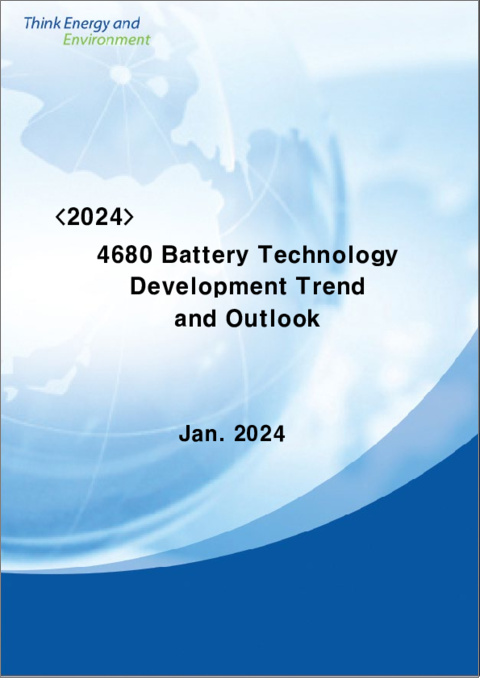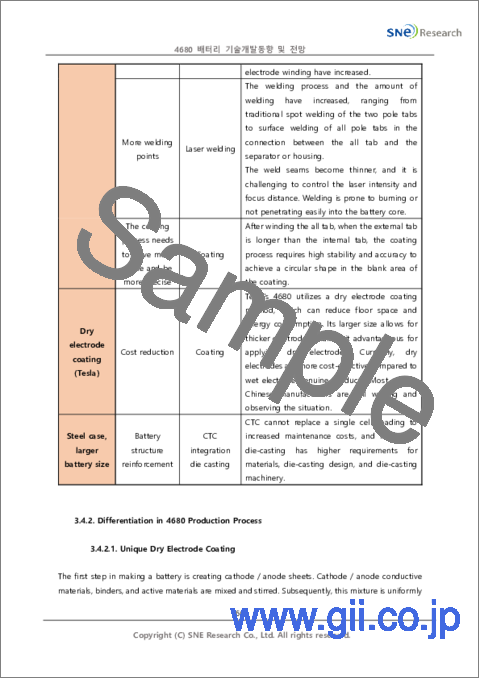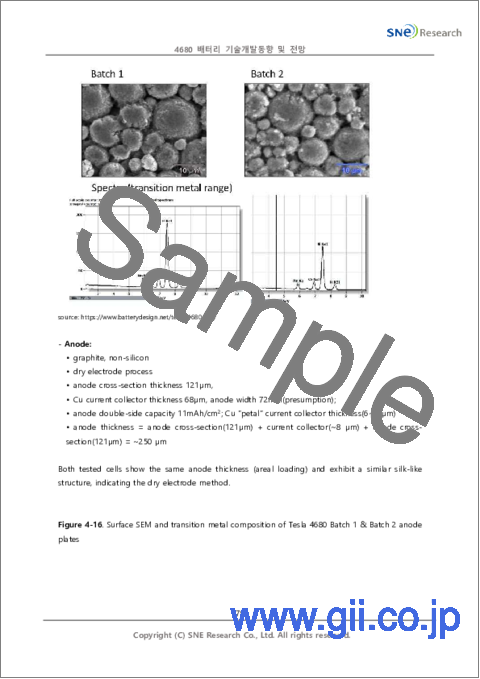|
|
市場調査レポート
商品コード
1419616
4680電池技術の開発動向と見通し4680 Battery Technology Development Trend and Outlook |
||||||
|
|||||||
| 4680電池技術の開発動向と見通し |
|
出版日: 2024年01月11日
発行: SNE Research
ページ情報: 英文 330 Pages
納期: お問合せ
|
- 全表示
- 概要
- 目次
Teslaは、4680のような大型円筒形電池生産に使用されるドライ電極プロセス(DBE)のMaxwell Technologiesを買収しました。ドライ電極プロセスの特徴は、乾燥に必要なエネルギーが少ないこと、乾燥工程に必要な工場面積が小さいこと、生産コストが低いことです。ドライ電極プロセスが両方の電極に適用されれば、大幅なコスト削減につながり、EVメーカーと生産企業にとってWin-Winの状況が生まれる可能性があります。ドライ電極プロセスは、Teslaが4680電池に採用している製造技術の1つであり、4680生産にさまざまな技術を導入することで、全体で56%のコスト削減が見込まれます。
Teslaは現在、テキサス州オースティンにあるギガファクトリーでドライコート電極を用いた4680セルを生産しており、そこではModel YとCybertruckが生産されています。入手可能な情報によると、Teslaは生産目標を達成するために4680セルを迅速に生産するのに必要な規模のドライコーティングプロセスをまだ完了していません。しかし、Panasonic、LG、CATL、EVE、BAK、SVOLTなど数社が4680セルの開発と量産に参入しています。4680の動向は世界的に勢いを増しており、BMW、Daimler、Apple、Lucid、Rivian、Xiaopeng、NIO、FAW、JAC Motorsなどが4680電池の採用を発表しています。
xEV用4680電池の需要は2025年までに約72GWh、2030年までに約650GWhに達すると予測されます。Teslaでは2025年までに約80GWh、BMWでは約59GWh、その他の企業では2025年までに約44GWhと推定されています。
ドライコーティングプロセスの課題にもかかわらず、4680セルの採用には複数の理由があります。以下は4680セルの突出した利点です。
(1)高いエネルギー密度
4680セルの容量は、外形寸法の変更のみで、2170セルの5倍です。さらに、Si/C(シリコン/カーボン)負極を使用することで、エネルギー密度を10%向上させることができます。さらに、Si/C負極を使用することで、エネルギー密度を最大20%向上させることができ、300Wh/kgを超えます。
(2)安全性
その「円筒形」設計は、電池パック内の熱伝導に関連する重大な安全問題である熱暴走に対してもっとも強力なソリューションと考えられています。近年の電池事故はすべて、パック内の特定の電池セルの熱暴走に起因しており、大量の熱を発生させ、その熱が周囲の電池セルを加熱し、熱暴走が伝播する結果となっています。
しかし、円筒形電池はセル容量が小さいため、角形やパウチ形の電池に比べて、1つの電池で熱暴走により放出されるエネルギーが小さく、熱暴走が伝播する可能性が低くなります。円筒形のデザインは湾曲しているため、電池間の熱伝導がやや制限されます。つまり、円筒形電池はその曲面によって完全に接触していても、かなりの隙間があるため、電池間の熱伝導がやや制限されます。
(3)急速充電性能
4680電池は、充電速度を向上させるために構造を変更し、材料システムの高速充電要件に適応しています。さらに、オールフラッグ設計を取り入れ、これが充電速度の加速にさらに寄与しています。
(4)高い生産効率→低いコスト
円筒形電池は、最初に市販されたリチウムイオン電池であり、もっとも成熟した生産プロセスを持っています。これは角形やパウチ形の電池に比べて組立効率が高いことに反映されています。4680の現在の生産効率は不明ですが、同心円状の巻線設計を持つ円筒形電池の特性が生産速度を決定しています。大型の円筒形電池は小型のものより生産速度が低いにもかかわらず、角形電池やパウチ形電池よりはるかに速いです。1865/2170電池の生産速度は通常200PPM(1分あたり電池200個)程度です。一方、容量が200Ah未満の角形電池は10~12PPM程度、容量が200Ahを超える大型角形電池は10PPM程度です。パウチ形電池の生産効率はさらに低いです。
(5)スケールアップ→BMSの複雑性の軽減
Teslaの場合、円筒形電池セルの容量が圧倒的に小さいため、一定の電力性能を達成するには膨大なセルの総数が必要でした。例えば、18650タイプでは7,000セル以上、2170タイプでは4,000セル以上が必要でした。このセル数の多さは、電池システムの熱管理という点で大きな課題をもたらしました。そのため、多くの自動車メーカーは円筒形電池の採用を敬遠していました。しかし、4680時代の到来により、必要な電池セル数は960~1,360セルに減少しました。セル数の減少は、パック内のスペース利用の改善と、必要なバッテリーマネジメントシステム(BMS)の大幅な簡素化を意味し、大型円筒形電池の放熱に関する問題に対処します。
当レポートでは、4680電池技術について調査し、開発動向、生産見通し、市場規模と成長率、材料と技術の分析などを提供しています。
目次
第1章 4680円筒形電池の概要
- Tesla Battery Dayの分析
- Battery Dayのサマリーと主な発見
- Teslaの電池セル設計
- Teslaの電池セル製造プロセス
- TeslaのSi負極
- TeslaのHi-Ni正極
- Teslaのセル車両統合
- Teslaのセルコスト改良
- Teslaの4680電池開発
- 46xx電池のロードマップ
- 新しい46xxセルの設計
- 新しい46xxセルの生産
第2章 4680電池の開発動向
- コスト削減と効率化の需要の増加
- 厳しい安全要件
- 将来の動向としての急速充電
- 市場参入に向けた電池メーカーの競合
- Teslaの開発動向
- 世界のOEMのレイアウト加速
- 46xx電池の詳細な仕様:メーカー別
第3章 4680電池の詳細な技術
- 正極
- 負極
- その他の電池材料
- 生産工程
第4章 Teslaの4680電池パックの分解
- 概要
- 電池の分解と分析
- Teslaの4680電池のセル、パック、エンジニアリングの分析
第5章 Teslaの4680電池セルの分解と特性
- サマリー
- 概要
- 過去の研究
- 詳細な分析
- 具体的な実験
- 結果と考察
- 結論
第6章 4680電池の成功に向けた技術
- マルチタブ技術
- タブ溶接技術
- 冷却技術
第7章 4680電池のエネルギー密度の向上とコスト削減
- 概要
- エネルギー密度(上矢印)/急速充電(上矢印)/コスト(下矢印)
- 高濃度電解質の採用
- 4680電解質の主要企業
第8章 4680電池の熱問題の予測と緩和策
- 実験のサマリー
- 実験方法
- 熱伝達モデル方程式
- 実験結果と考察
- 実験の結論
第9章 円筒形LIBセルの設計、特性、製造
- 概要
- 実験材料と方法
- 実験結果と考察
- 実験の結論
第10章 無鉛円筒形LIBセルのセルサイズ、ハウジング材質、その影響
- 全体の概要
- 実験
- 実験結果と考察
- 実験の結論
第11章 4680セルメーカーと自動車OEMの現状
- Tesla
- Panasonic
- LGES
- SDI
- EVE
- BAK
- CATL
- Guoxuan Hi-TECH
- SVOLT
- CALB
- Envision AESC
- LISHEN
- Easpring
- Kumyang
- BMW
- Rimac
第12章 Teslaの4680電池特許の分析
- タブレス電極電池(PTC/US2019/059691)
- タブレスエネルギー貯蔵機器とその生産方式(PTC/US2021/050992)
- ドライプロセス特許1(粒子状非繊維化バインダーの含有:US11545666 B2)
- ドライプロセス特許2(電極バインダーの不動態化に向けた組成物と方法:US11545667 B2)
第13章 4680電池市場の見通し
- 全体的な市場見通し
- 4680の主要材料市場の見通し
- 4680需要の見通しと生産能力の見通し
第14章 Teslaの4680セル生産の見通し
- コンサルティング企業による4680の見通し
- Tesla/BMWの4680需要の見通し
- TeslaのCybertruck向け4680セル生産の見通し
Tesla acquired Maxwell Technologies for the dry battery electrode process (DBE) used in the production of large cylindrical batteries like the 4680. The dry electrode process is characterized by low energy requirements for drying, a smaller factory footprint for the drying process, and lower production costs. If the dry coating process is applied to both electrodes, it could lead to significant cost reductions, creating a win-win situation for EV manufacturers and production companies. The dry electrode process is one of the manufacturing technologies employed by Tesla for the 4680 battery, and with the implementation of various technologies for 4680 production, an overall cost reduction of 56% is anticipated.
Tesla is currently producing 4680 cells with dry-coated electrodes at the Gigafactory in Texas Austin, where Model Y and Cybertruck are being manufactured. According to available information, Tesla has not yet completed the dry coating process on the scale required to rapidly produce 4680 cells to meet production targets. However, several companies, including Panasonic, LG, CATL, EVE, BAK, SVOLT, and others, have entered the development and mass production of 4680 cells. The 4680 trend is gaining momentum globally, with announcements from BMW, Daimler, Apple, Lucid, Rivian, Xiaopeng, NIO, FAW, JAC Motors, and others regarding the adoption of 4680 batteries.
According to the forecasts from SNE Research, the demand for xEV 4680 cells is projected to be approximately 72 GWh by the year 2025 and around 650 GWh by the year 2030. For Tesla, it is estimated to be around 80 GWh by the year 2025, for BMW around 59 GWh, and for other companies, approximately 44 GWh by the year 2025.
Despite the challenges of the dry coating process, there are several reasons for the adoption of the 4680 cells. Below are listed the outstanding advantages of the 4680 cells:
- (1)High energy density: The capacity of the 4680 cells is five times that of the 2170 cells, with only a change in external dimensions. Additionally, by utilizing a Si/C (Silicon/Carbon) anode, it is possible to achieve a 10% increase in energy density. Furthermore, with the use of a Si/C anode, the energy density can be further increased by up to 20%, reaching beyond 300 Wh/kg.
- (2)Safety: The "cylindrical" design is considered the most robust solution for thermal runaway, a critical safety issue associated with heat propagation within battery packs. Recent battery incidents have all been attributed to thermal runaway in specific battery cells within the pack, leading to the generation of a significant amount of heat that, in turn, heats up surrounding battery cells, resulting in the propagation of thermal runaway.
However, cylindrical batteries have a smaller cell capacity, and the energy released due to thermal runaway in a single battery is lower, reducing the likelihood of propagation compared to prismatic and pouch-shaped batteries. The curvature of the cylindrical design somewhat limits the heat transfer between batteries. In other words, even when cylindrical batteries are in complete contact due to their curved surfaces, there is still a significant gap, which somewhat restricts the heat transfer between batteries.
- (3)Rapid charging performance: The 4680 battery undergoes structural changes to enhance its charging speed, adapting to the high-speed charging requirements of the material system. Additionally, it incorporates an "All flag" design, further contributing to the acceleration of charging speeds.
(4)High production efficiency -> Low cost
Cylindrical batteries were the first commercially available lithium-ion batteries and have the most mature production processes. This is reflected in higher assembly efficiency compared to prismatic and pouch-shaped batteries. While the current production efficiency of the 4680 is unknown, the characteristics of cylindrical batteries, with their concentric winding design, determine the production speed. Despite larger cylindrical batteries having a lower production speed than smaller ones, they are still much faster than prismatic and pouch-shaped batteries. The production rate for 1865/2170 batteries is typically around 200PPM (200 batteries /minute). Meanwhile, for prismatic batteries with a capacity below 200Ah, the rate is around 10-12PPM, and for larger prismatic batteries with a capacity exceeding 200Ah, it's around 10PPM. The production efficiency of pouch-shaped batteries is even lower.
(5)Scaling up -> Reduced BMS complexity
For Tesla, the predominantly smaller capacity of cylindrical battery cells meant that achieving specific power performance required an enormous total number of cells. For instance, 7000+ cells of the 18650 type or 4000+ cells of the 2170 type were needed. This high cell count posed significant challenges in terms of thermal management for the battery system. Consequently, many automakers were discouraged from adopting cylindrical batteries. However, with the advent of the 4680 era, the required number of battery cells has decreased to 960-1360 cells. The reduced cell count implies improved space utilization in the pack and a substantial simplification of the required Battery Management System (BMS), addressing issues related to heat dissipation in large cylindrical batteries.
In this report, SNE Research systematically organizes information from various sources, including presentations from each company related to the 4680, scattered data from disassembly and performance tests, and reviews of key papers. Through this comprehensive approach, the report analyzes the practical effects and performance improvements of the 4680 introduction. Furthermore, by referencing data from external research institutions, our report aims to assist readers in understanding the outlook and scale of the large cylindrical battery market.
Additionally, we provides an overview of the current status and key products of 4680 manufacturers. It also highlights the scale of Gigafactory facilities and indicates the correlation between the production volume and quantity of Cybertruck, offering intriguing insights into the manufacturability of the 4680. The goal is to provide comprehensive insights to researchers and individuals interested in this field.
The Strong Point of this report is as below:
- 1. Summarizing the developmental trends and information related to the 4680 for an overall understanding and ease of comprehension.
- 2. In-depth analysis and summarization of the disassembly reports for 4680 cells and packs to enhance understanding.
- 3. Assessing the market and production outlook for 4680 batteries to understand market size and growth rates.
- 4. Detailed analysis of materials and technologies applied to the 4680 through the examination of academic papers.
Table of Contents
1. 4680 Cylindrical Battery Overview
- 1.1. Tesla Battery Day Analysis
- 1.2. Battery Day Summary and Key Findings
- 1.3. Tesla Battery Cell Design
- 1.4. Tesla Battery Cell Manufacturing Process
- 1.4.1. Coating
- 1.4.2. Winding
- 1.4.3. Assembly
- 1.4.4. Formation
- 1.5. Tesla Si-anode
- 1.6. Tesla Hi-Ni Cathode
- 1.7. Tesla Cell - Vehicle Integration
- 1.8. Tesla Cell Cost Improvement
- 1.9. Tesla 4680 Battery Development
- 1.9.1. Development History
- 1.9.2. Battery Specification
- 1.9.3. Battery-adopted Tesla EV
- 1.9.4. Battery Supplier
- 1.9.5. Battery Production Timing
- 1.10. 46xx Battery Roadmap
- 1.10.1. New 46xx Cell Design
- 1.10.2. New 46xx Cell Production
2. 4680 Battery Development Trend
- 2.1. Increased Demand for Cost Reduction and Efficiency
- 2.2. Demanding Safety Requirements
- 2.3. Fast Charing as Future Trend
- 2.4. Battery Makers Competition for Market Entrance
- 2.5. Tesla Development Trend
- 2.5.1. 4680 Sales Volume and Production Capacity
- 2.5.2. 4680 Demand Calculation
- 2.6. Global OEMs' Layout Acceleration
- 2.7. 46xx Battery Detailed Specification by Maker
3. 4680 Battery Detailed Technology
- 3.1. Cathode
- 3.1.1. Application of Ultra High Nickel
- 3.1.2. Establishment of Production Capacity
- 3.1.3. Upgrade of Production Technology
- 3.2. Anode
- 3.2.1. Silicon-based Development
- 3.2.2. Silicon-based Development Timeline
- 3.2.3. Si-anode Modification
- 3.2.4. Acceleration of Si-anode Industrialization
- 3.3. Other Battery Materials
- 3.3.1. SWCNT Conductive Material
- 3.3.2. Steel Battery Can
- 3.3.3. Al Battery Can
- 3.3.3.1. Al housing Cell Design Concept
- 3.3.3.2. 46xx Large-size Cylindrical Cell
- 3.3.3.3. 46xx Jelly Roll Concept
- 3.3.3.4. 46xx Jelly Roll Heat Transfer and Distribution
- 3.3.3.5. 46xx Jelly Roll Heat Simulation
- 3.3.3.6. 46xx Jelly Roll Cooling Improvement
- 3.4. Production Process
- 3.4.1. 4680 Battery Production Process Technology
- 3.4.2. 4680 Production Process Differentiation
- 3.4.2.1. Dry Electrode Coating
- 3.4.2.2. Dry Process Examples
- 3.4.2.3. Electrode and Tab Integrated Cutting
- 3.4.2.4. Difficulty of Laser Welding
- 3.4.2.5. Integrated Die casting and CTC
4. Tesla 4680 Battery Pack Disassembly
- 4.1. Overview
- 4.2. Battery Disassembly and Analysis
- 4.3. Tesla 4680 Battery Cell, Pack, and Engineering Analysis
- 4.3.1. Tesla 4680 Battery Design Data
- 4.3.2. Pack Structure (Cell Direction)
- 4.3.3. Electricity Connection with Each Cell
- 4.3.4. Suggested Pack Assembly Method
- 4.3.5. Model 3 Pack Analysis
- 4.3.5.1. Pack Analysis Result (Summary)
- 4.3.5.2. Details of Heat Release
- 4.3.6. Model 3 Battery Current Collector
5. Tesla 4680 Battery Cell Disassembly and Characteristics
- 5.1. Summary
- 5.2. Overview
- 5.3. Previous Studies
- 5.4. Detailed Analysis
- 5.5. Specific Experiment
- 5.5.1. Test Cell Overview
- 5.5.2. Cell Disassembly and Substance Extraction
- 5.5.3. Structure and Element Analysis
- 5.5.4. 3 Electrode Analysis
- 5.5.5. Electrical Characteristics
- 5.5.6. Thermal investigation
- 5.6. Result and Consideration
- 5.6.1. Cell and Jelly roll Structure
- 5.6.2. Electrode Design
- 5.6.3. Material Characteristics
- 5.6.4. 3 Electrode Analysis
- 5.6.5. Capacity and Impedance Analysis
- 5.6.6. Similar OCV, DVA and ICA Analysis
- 5.6.7. HPPC Analysis
- 5.6.8. Thermal Characteristics Analysis
- 5.7. Conclusion
6. Technologies for Success of 4680 Battery
- 6.1. Multi(all) Tab Technology
- 6.2. Tab Welding Technology
- 6.3. Cooling Technology
7. 4680 Battery Energy Density Improvement and Cost Down
- 7.1. Overview
- 7.2. Energy Density (up arrow)/ Fast Charging (up arrow)/ Cost (down arrow)
- 7.2.1. Blade Battery / High-Ni Prismatic Battery Comparison
- 7.2.2. Increase of Fast Charging Rate
- 7.2.3. Production Improvement and Cost Down with Dry Electrode (DBE)
- 7.3. High-Concentration Electrolyte Adoption
- 7.3.1. Decrease of 4680 Electrolyte Q'ty / GWh
- 7.3.2. High-Concentration Electrolyte and LiFSI Addition
- 7.3.3. Fluorine FEC Addition
- 7.4. 4680 Electrolyte Major Players
8. 4680 Battery Heat Problem Prediction and Mitigation Solutions
- 8.1. Experiment Summary
- 8.2. Experiment Method
- 8.3. Heat Transfer Model Equation
- 8.4. Experiment Result and Discussion
- 8.5. Experiment Conclusion
9. Cylindrical LIB Cell Design, Characteristics and Manufacturing
- 9.1. Overview
- 9.2. Experiment Material and Method
- 9.2.1. Cell Design
- 9.2.2. Cell Properties
- 9.2.3. Cell Energy Density
- 9.2.4. Cell Impedance
- 9.2.5. Cell Temperature
- 9.3. Experiment Result and Consideration
- 9.3.1. Cylindrical LIB Cell Design
- 9.3.2. Jelly Roll Design
- 9.3.2.1. Geometry
- 9.3.3. Tab Design
- 9.3.4. Cell Properties
- 9.3.4.1. Cell Energy Density
- 9.3.4.2. Cell Resistance
- 9.3.4.3. Cell Thermal Behavior
- 9.3.5. Jelly Roll Manufacturing
- 9.4. Experiment Conclusion
10. Cell size and Housing Material and their Influences of Tabless Cylindrical LIB Cell
- 10.1. Overall Overview
- 10.2. Experiment
- 10.2.1. Reference cell
- 10.2.2. Cell Modeling
- 10.2.2.1. Cell Size and Geometric Model
- 10.2.2.2. Jelly Roll Electrode Layer
- 10.2.2.3. Hollow core
- 10.2.2.4. Tabless Design
- 10.2.3. Cell Housing
- 10.2.4. Thermal - Electrical - Electrochemical Framework
- 10.2.4.1. Boundary Conditions and Discretization
- 10.3. Experiment Result and Discussion
- 10.3.1. Energy Density
- 10.3.1.1. Influence of Cell Diameter
- 10.3.1.2. Influence of Cell Height
- 10.3.1.3. Influence of Housing Material
- 10.3.2. Fast Charging Performance
- 10.3.2.1. Realization of Heat Transfer Coefficient Control Algorithm
- 10.3.2.2. Influence of Cell Height and Housing Material with Axial Cooling
- 10.3.2.3. Influence of Cell Diameter and Housing Material with Axial Cooling
- 10.3.2.4. Influence of Tab Design and Scaling of Series Resistance
- 10.3.2.5. Influence of Cell Size and Housing Material on Fast Charging
- 10.3.1. Energy Density
- 10.4. Experiment Conclusion
11. 4680 Cell Maker and Car OEMs Current Status
- 11.1. Tesla
- 11.2. Panasonic
- 11.3. LGES
- 11.4. SDI
- 11.5. EVE
- 11.6. BAK
- 11.7. CATL
- 11.8. Guoxuan Hi-TECH
- 11.9. SVOLT
- 11.10. CALB
- 11.11. Envision AESC
- 11.12. LISHEN
- 11.13. Easpring
- 11.14. Kumyang
- 11.15. BMW
- 11.16. Rimac
12. Tesla 4680 Battery Patent Analysis
- 12.1. Tabless Electrode Battery (PTC/US2019/059691)
- 12.2. Tabless Energy Storage Devices and their Manufacturing Methods (PTC/US2021/050992)
- 12.3. Dry Process Patent 1(Inclusion of particulate nonfibrification binder: US11545666 B2)
- 12.4. Dry Process Patent 2 (Compositions and methods for passivation of electrode binders: US11545667 B2)
13. 4680 Battery Market Outlook
- 13.1. Overall Market Outlook
- 13.2. 4680 Major Materials Market Outlook
- 13.2.1. Si-based Anode
- 13.2.2. Hi-Ni Ternary Cathode
- 13.2.3. LiFSI
- 13.2.4. Composite Copper Foil
- 13.2.5. PVDF Binder
- 13.2.6. CNT Conductor
- 13.2.7. Laser Welding Equipment
- 13.2.8. Housing CAN
- 13.2.9. Ni plated CAN
- 13.3. 4680 Demand Outlook and Capacity Outlook
14. Tesla 4680 Cell Production Outlook
- 14.1. 4680 Outlook by Consulting Company
- 14.2. Tesla/BMW 4680 Demand Outlook
- 14.3. Tesla 4680 Cell for Cybertruck Production Outlook
- 14.3.1. 4680 Giga Texas Production Estimates
- 14.3.2. 4680 Cell Production Capacity vs. Cybertruck Production Volume (Units)
- 14.3.3. 4680 Cell Annual Capacity vs. Daily Production Volume
- 14.3.4. 4680 Cell Production Capacity vs. Production Time Change Trend
- 14.3.5. Tesla Giga Factory P/P Line Major Processes






